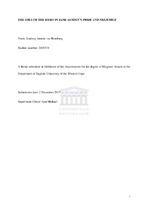| dc.description.abstract | In this thesis I focus on the ways I believe Jane Austen re-imagines the idea of the hero. In popular fiction of her time, such as Samuel Richardson’s Sir Charles Grandison (1753), what we had as a hero figure served as a male monitor, to guide and instruct the female heroine. The hero begins the novel fully formed, and therefore does not go through significant development through the course of the novel. In addition to Sir Charles Grandison, I read two popular novels of Austen’s time, Fanny Burney’s Cecilia and Maria Edgeworth’s Belinda. An examination of Burney’s construction of Delvile and Edgeworth’s construction of Clarence Hervey allows me to engage with popular conceptions of the ideal hero of the late eighteenth and early nineteenth centuries. Burney and Edgeworth deviate from these ideals in order to accommodate conventions of the new Realist novel. I argue that Austen reimagines her male protagonist so that hero and heroine are well-matched and discuss, similarly, how Burney and Edgeworth create heroes as a complement to their heroines. Austen’s re-imagining of her male protagonist forms part of her contribution to the genre of the Realist novel. Austen suggests the complexity of her hero through metaphors of setting. I discuss the ways in which the descriptions of Pemberley act as a metaphor for Darcy’s character, and explore Austen’s adaptations of the picturesque as metaphors to further plot and character development. I offer a comparative reading of Darcy and Pemberley with Mr
Bennet and Longbourn as suggestive in understanding the significance of setting for the heroine’s changing perceptions of the character of the hero. I explore Austen’s use of free indirect discourse and the epistolary mode in conveying “psychological or moral conflict” in relation to Captain Wentworth in Persuasion and Mr Knightley in Emma, offering some comparison to Darcy. This lends itself to a discussion on the ways in which Austen’s heroes may be read as a critique of the teachings of Lord Chesterfield’s Letters to His Son (1774). I conclude the thesis with a discussion of the ways in which Darcy has influenced the stereotype of the modern romance hero. Using two South African romance novels I suggest the ways in which the writers adapt conventions of writing heroes to cater for the new black
South African middle class at which the novels are aimed. My reading of Jane Austen’s novels will highlight the significance of Austen’s work in contemporary writing, and will question present-day views that the writing of the
eighteenth- and nineteenth-centuries is not relevant to African literature. | en_US |

